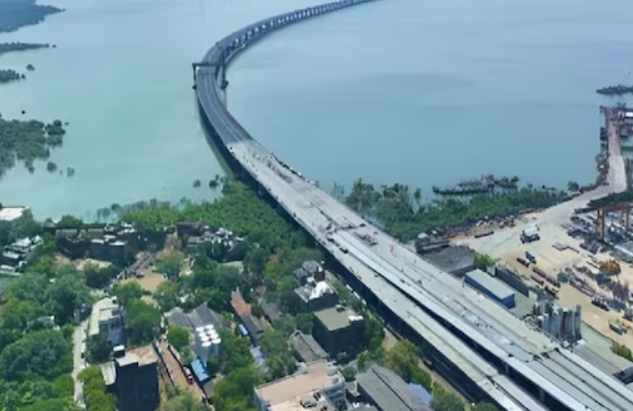Mumbai Trans Harbour Link (MTHL) Inaugurated
Recently, Prime Minister Narendra Modi inaugurated the Mumbai Trans Harbour Link (MTHL), also known as Atal Setu, marking the opening of India’s longest sea bridge to date. The 21.8-kilometer link built at a cost of over Rs 17,840 crores aims to reduce travel time between South Mumbai and Navi Mumbai from 120 minutes to just 20 minutes.
The 6-lane Mumbai Trans Harbour Link (MTHL), spanning across Thane Creek, has been under construction since 2018. The viaduct includes 16.5 kilometers over water along with a 5.5 kilometer section over land. It aims to reduce travel time between South Mumbai and Navi Mumbai from 120 minutes to just 20 minutes.
As India’s longest sea link, the MTHL lays the foundation for more such ambitious infrastructural visions harnessing domestic talent and technology leveraging scientific insights.
Connectivity Impact
Starting at Sewri, the route crosses Thane Creek and links Mumbai with the upcoming Navi Mumbai international airport and proximate industrial hubs. It will offer direct connectivity between Mumbai and Navi Mumbai, facilitating seamless people and freight movement.
The project encompasses interchanges at Sewri, Shivaji Nagar, Jasai and Chirle. Once fully operational, motorists from Bandra can expect to reach Navi Mumbai within 40 minutes. It will also ease access to surrounding logistics and transport infrastructure.
Strategic Significance
As India’s longest sea bridge to date, the MTHL holds immense strategic importance for integrated Mumbai metropolitan region development. By connecting leading economic centers, it will stimulate productivity, jobs and growth – granting a major infrastructural advantage.
National Infrastructure Priorities
The link constitutes a vital component of Prime Minister Modi’s $1.2 trillion national infrastructure expansion vision over 5 years. The goal is to elevate India’s competitiveness and benchmark infrastructure globally including through major public works.
Resilient Design
The bridge incorporates 254 seismic bearings that act as shock absorbers between the deck and supports during tremors, protecting structures. Ductile concrete piers also bend safely when stressed.
Special concrete blends resist maritime corrosion while minimizing long-term cracks even in extreme conditions. Precast segmented decks enable rapid, flawless assembly.
Caisson foundations, crucial for sea bridges, provide watertight stable bases to withstand challenging marine factors. Straight underwater construction relied on skilled divers and remotely operated vehicles.
Risk Factors
However, some analysts caution that over-dependence on public expenditure risks debt sustainability. Hence, attracting complementary private and institutional investments is equally pivotal for fully realizing infrastructure ambitions.
Month: Current Affairs - January, 2024
Category: India Nation & States Current Affairs








